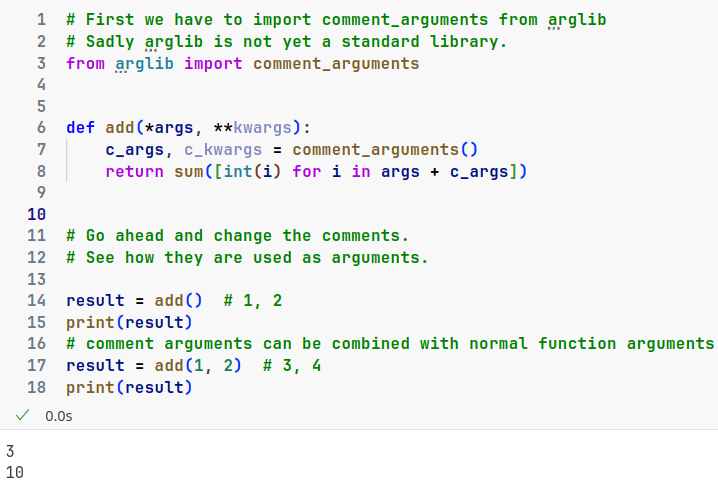Python allows programmers to pass additional arguments to functions via comments.
Now armed with this knowledge head out and spread it to all code bases.
Feel free to use the code I wrote in your projects.
Link to the source code: https://github.com/raldone01/python_lessons_py/blob/v2.0.0/lesson_0_comments.ipynb
Image transcription:
# First we have to import comment_arguments from arglib
# Sadly arglib is not yet a standard library.
from arglib import comment_arguments
def add(*args, **kwargs):
c_args, c_kwargs = comment_arguments()
return sum([int(i) for i in args + c_args])
# Go ahead and change the comments.
# See how they are used as arguments.
result = add() # 1, 2
print(result)
# comment arguments can be combined with normal function arguments
result = add(1, 2) # 3, 4
print(result)
Output:
3
10
This is version v2.0.0 of the post: https://github.com/raldone01/python_lessons_py/tree/v2.0.0
Note:
v1.0.0 of the post can be found here: https://github.com/raldone01/python_lessons_py/tree/v1.0.0
Choosing lib as the name for my module was a bit devious.
I did it because I thought if I am creating something cursed why not go all the way?
Regarding misinformation:
I thought simply posting this in programmer humor was enough.
Anyways, the techniques shown here are not yet regarded best practice.
Decide carefully if you want to apply the shown concepts in your own code bases.

The
add()function (that is available in the source code) basically uses some built in debugging tools to find out where in the code the function is called, and then parses the comment from the file and uses it for adding stuff.I’ve never tried (becuse why would you…) but something similar can probably be built in any interpreted language
It’s not something Python does by design
Thanks :) ! Could you tell me what use case/purpose such function can have from a dev perspective?
This stuff is normally used for creating human readable error messages. E.g. printing the line of your code that actually set off the exception
I'd say nothing that can't be achieved by docstrings.
This specific use case? To make a meme, mainly ¯\(ツ)/¯
As for the components: Parsing comments have been used for stuff like type hints / formatting / linting, tho generally not at run time (afaik).
The tooling for finding out where something is called from can be used to give a better understanding of where things go wrong when an exception happens or similar, to add to logs.
I would say that in general you don’t need either functionality except for certain edge-usecases
Thank you ! 😄
We actually use method comments for user documentation as well. Only on specific business methods, but it's nice to have a good comment for the dev and a tooltip for the user at the same time.